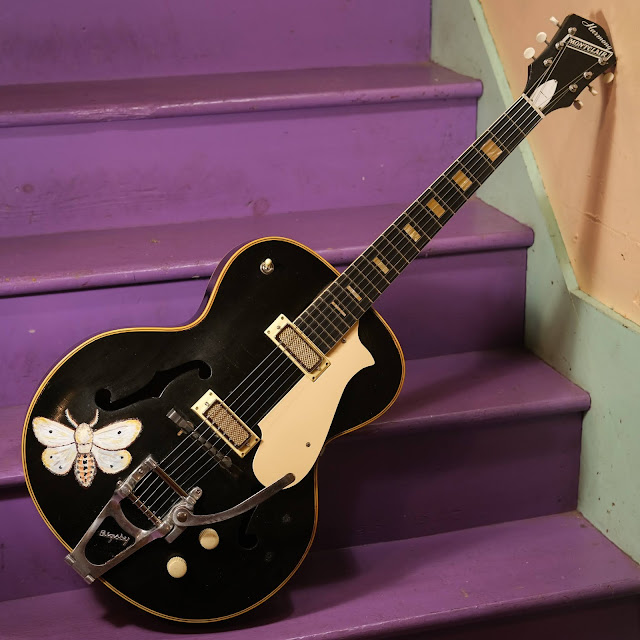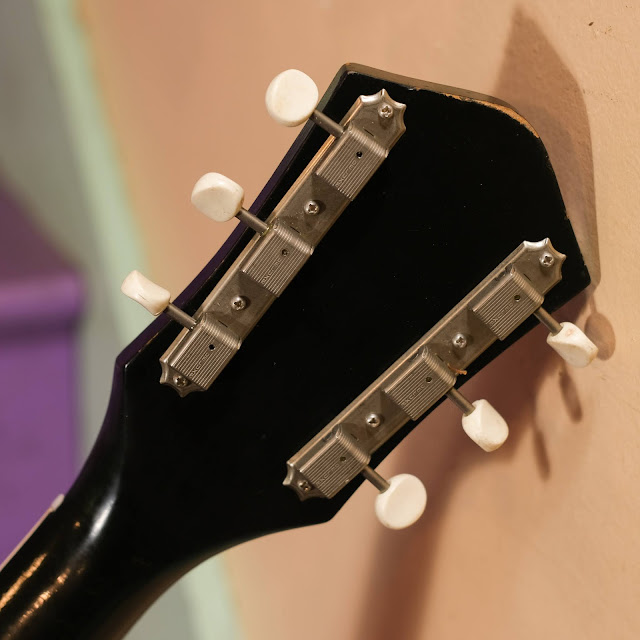1960s Harmony Montclair Electrified Rubber Bridge Archtop Guitar
My rubber-bridge-obsessed (note this "foxes" guitar and this baritone 12 string guitar) buddy Steve sent this guitar as an original acoustic husk (in wonky shape) up here some time ago. My mission was to turn it into a rubber-bridge electric archtop guitar with two of the kick-butt goldfoil mini-humbuckers that I've been scrounging off of eBay now and then. He also wanted a Bigsby on it... and he told me to paint it with something cool.
I figured -- this tone has a nighttime, early-jazz, clean, weirdo vibe -- clearly it needs a fantasized tiger moth painted on it! For obvious reasons, this box is now "The Moth."
After a tremendous amount of work (due to it needing all the normal acoustic stuff fixed and then a conversion to electric), this guitar plays like a champ and has killer tone. I don't know what magic stuff went into it but both I and my friend Mike (who I handed it to for testing) were captivated enough by it to lose a lot of time picking away on it. There's something nostalgic about the sound of this thing. It sounds old but at the same time, the not-quite-palm-muted, not-quite-foam-muted sound of the rubber bridge saddle gives it a very modern approach to old. Now I'm being annoying -- but there you have it. It's seductive.
Repairs included: a neck reset, board plane and refret with medium fretwire, new (Gotoh relic) tuners at the headstock, new (copied from the cut-up original) pickguard, twin small soundpost installs in the body, body-cut and fit of two mini-humbuckers and pickup rings, new fully-shielded wiring harness with 500k pots, .010 Mallory capacitor + Switchcraft jack + normal 3-way, Bigsby install, general cleaning, moth painting, and setup. There's also a new strap button at the heel, too.
Setup notes: it plays perfectly with 1/16" action overall at the 12th fret, strung with 52w-11 D'Addario Chromes flatwound strings. The neck is straight and the truss rod works. There's a little room to adjust the bridge up/down, too, but it's very stable.
Scale length: 25 1/8"
Nut width: 1 3/4"
String spacing at nut: 1 1/2"
String spacing at bridge: 2 1/16"
Body length: 20"
Lower bout width: 16 3/8"
Waist width: 9 3/8"
Upper bout width: 11 1/2"
Side depth at endpin: 3 3/8"
Side depth at endpin: 3 3/8"
Top wood: solid spruce
Back wood: solid maple?
Sides wood: solid maple?
Sides wood: solid maple?
Bracing type: two tonebars + soundposts
Fretboard: ebonized maple/pearwood, plastic nut
Bridge: rosewood, adjustable + rubber saddle
Neck feel: medium C-shape, 10" board radius
Condition notes: while there are no cracks and the guitar's in really good cosmetic condition for its age (finish weather-check and minor scratching), it's clearly been modified a lot as described above. The original pickguard and tuners are stowed with the guitar but the original bridge is now modified to accept a rubber saddle on top of it (compensated). The knobs are period but not original to the guitar and the Bigsby is an older unit but not same-period.

















Comments